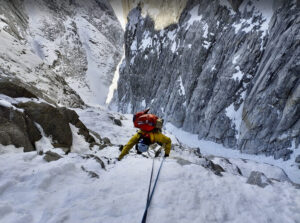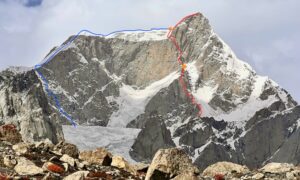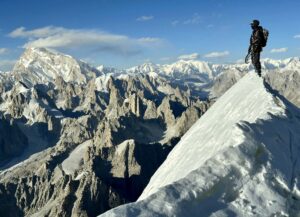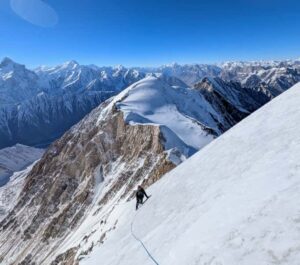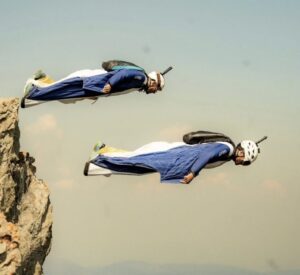More and more climbers are combining their ascents with paragliding. Usually, they do the obvious: Jump from a summit they’ve just climbed. Sometimes, they paraglide from partway up the mountain.
But Will Sim and Fabi Buhl may have started a new trend. They recently made the first ascent of Gulmit Tower, a 5,800m granite spire in Hunza, by gliding to its base from the air, then climbing it. From the summit, they rappeled down, then paraglided back to their hotel!
Safer, faster
“What would normally be a four-day approach, [we did] with our wings in 1.5 hours, town to base of the route,” Sim reported. They then climbed the “phenomenal” line up the tower.

During the climbing phase. Photo: Will Sim
The climbers, together with Aaron Drugati and photographer Jake Holland, spent five weeks paragliding around Hunza. They didn’t need a Base Camp. They mostly stayed at a hotel in Karimabad and flew wherever they needed.
When they set their sights on Gulmit Tower, they carried all the necessary gear in their paragliding harnesses, with some help from the two other pilots. Once they landed, they continued their approach on skis.
After resting in a tent at the base of the mountain, the climbing pair set off at 2 am. They wore crampons until a col, from which they started rock climbing. They summited, rapped down, then flew back to their hotel that same day, they told climbing.com.

The new line on Gulmit Tower. Photo: Instagram
On Gulmit Tower, Aaron Drugati didn’t climb but instead completed a crazy “combo” flight with his skis on and the subsequent descent (see below). Previously in the same expedition, Drugati broke a record by bagging the longest flight ever in Asia — 312km, over the Hispar Glacier.
Why is this Important?
Gulmit Tower had been attempted before, but never successfully. Its excellent granite was perfect for climbing, but the treacherous, highly broken glaciers leading to the tower had caused the failures.
Many unclimbed mountains in the Karakoram present similar barriers to access. This technique would smooth the way for first ascents by permitting safer access and exit.
Cross-country paragliding, combined with skiing and alpinism, multiplies the options for exploratory expeditions. It shows that adaptation is key to keeping the adventure alive.

